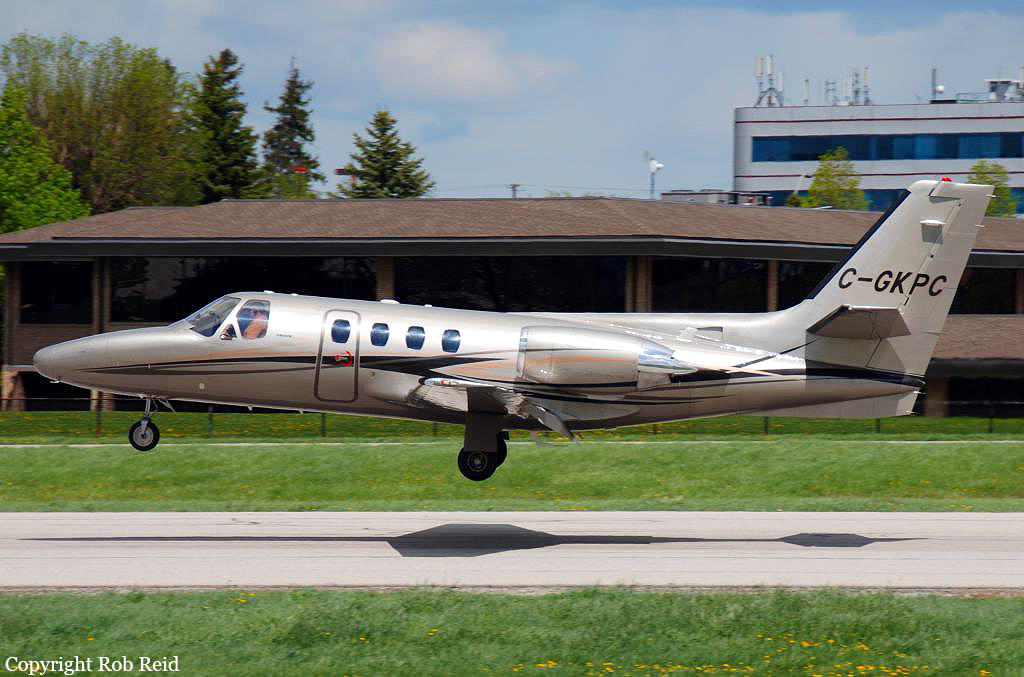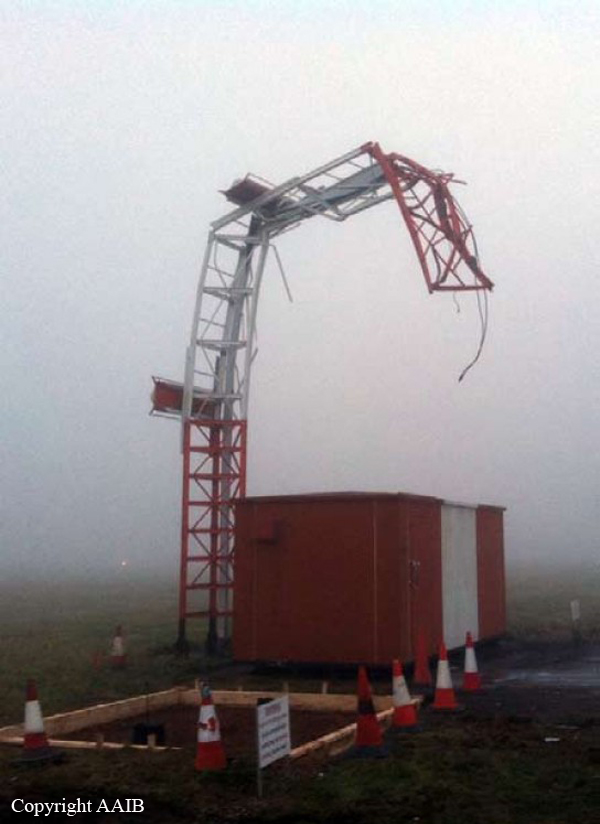Country
Crash of a Cessna 501 Citation I/SP in Stella Maris
Date & Time:
Feb 15, 2014 at 1640 LT
Registration:
C-GKPC
Survivors:
Yes
Schedule:
Fort Lauderdale - Stella Maris
MSN:
501-0253
YOM:
1983
Crew on board:
0
Crew fatalities:
Pax on board:
0
Pax fatalities:
Other fatalities:
Total fatalities:
0
Aircraft flight hours:
4579
Circumstances:
The aircraft belly landed at Stella Maris-Estate Airport, Bahamas. No one was hurt but the aircraft was damaged beyond repair. Apparently, the approach checklist was interrupted by the crew for unknown reason and the landing procedure was performed with the landing gear still retracted. The aircraft was owned by the private Canadian company Kelly Panteluk Construction and the airplane was inbound from Fort Lauderdale-Executive.





Crash of a Cessna 501 Citation I/SP in Trier: 4 killed
Date & Time:
Jan 12, 2014 at 1152 LT
Registration:
N452TS
Survivors:
No
Schedule:
Shoreham - Trier
MSN:
501-0231
YOM:
1981
Crew on board:
2
Crew fatalities:
Pax on board:
2
Pax fatalities:
Other fatalities:
Total fatalities:
4
Captain / Total hours on type:
32.00
Copilot / Total hours on type:
550
Aircraft flight hours:
4282
Aircraft flight cycles:
4413
Circumstances:
On Friday, 10 January 2014, the airplane had flown from Trier to Shoreham, where it landed at 1456 UTC. Two pilots and two passengers were on board the aircraft. Over the weekend, the passengers wanted to participate in a hunt. On the afternoon of 11 January 2014 the PIC told the service provider, tasked by the aircraft owner with the flight planning, to prepone the scheduled return flight on Sunday, 12 January 2014, from 1400 UTC to 1015 UTC. In the ATC flight plan Trier-Föhren Airfield was the destination aerodrome and Luxembourg Airport the alternate aerodrome. According to the flight plan the change of flight rules from IFR to VFR was to occur at reporting point PITES. The handling agent at Shoreham Airport stated that the PIC and the co-pilot had arrived on Sunday at 0850 UTC. The airport made the recordings of a video camera for apron surveillance available to the BFU. These recordings show that the airplane was refuelled in the presence of the pilots. The two passengers arrived at 0936 UTC and about 11 minutes later the aircraft taxied from the apron. At 1000 UTC, the airplane took off from runway 20. At 1138:25 hrs, the co-pilot established contact with Langen Radar. At that time the airplane was in Flight Level (FL) 170. At 1142:51 hrs, after the airplane had descended to FL140, the controller issued the descent clearance to FL70. Approximately one minute later the controller said: "… proceed direct destination again and descend altitude five thousand feet … Spangdahlem QNH one zero two five." The pilot in command acknowledged the clearance. At 1145:23 hrs the PIC said: "… standing by for cancelling IFR." The controller answered: "... roger, IFR is cancelled at one zero two five, your position is one five miles northwest of your destination airfield, squawk VFR, approved to leave." According to radar data, the airplane was approximately in FL90 and continued to fly with a southern heading. At 1147:26 hrs, about 5 NM east of the omnidirectional radio beacon Nattenheim (VOR NTM), the altitude was 4,900 ft AMSL. According to the radar data at 1148:10 hrs the airplane had reached 3,500 ft AMSL. The flight path continued east until 1149 hrs when, in the area of the city of Wittlich in an altitude of 3,500 ft AMSL, the airplane turned right. The ground speed was approximately 180 kt. In the course of the right turn until 1150:30 hrs, the altitude decreased further to about 2,800 ft AMSL and the ground speed to about 160 kt. At 1151:10 hrs the aircraft turned left maintaining altitude until it had reached a southern heading. From 1151:30 hrs on it continued to descend. At the time the airplane was approximately 6.7 NM from the runway threshold and about 0.5 NM north of the extended runway centre line. Approximately 15 seconds later it reached the extended runway centre line of runway 22 while it turned right into the final approach direction. It was in about 2,300 ft AMSL and approximately 5.7 NM from the runway. From 1152:20 hrs on, at approximately 4.6 NM from the threshold, the aircraft began to leave the extended runway centre line to the south. At that time, altitude was approximately 1,600 ft AMSL and ground speed about 160 kt. The last radar target was recorded at 1152:40 hrs with an altitude indication of approximately 1,300 ft AMSL and a ground speed of about 140 kt. The attention of several witnesses, located about 600 m north-east and south-east, respectively, of the accident site in the valley of the river Salm, was drawn to the airplane by engine noise. They congruently stated that the aircraft had come from the direction of the town Esch and flown in low altitude, below the fog or cloud cover, toward the south-west. One of the witnesses estimated the altitude was 15 to 20 m above the trees bordering the river Salm, approximately the same height as the open wire located in the area. According to congruent witnesses’ statements, the engine thrust was increased and the airplane pulled up shortly before reaching a wooded escarpment rising by about 60 m, banked left and disappeared in the fog. Immediately afterwards fire had become visible and impact noises had been heard. The airplane impacted the ground in an inverted position. The occupants suffered fatal injuries and the aircraft was destroyed. The Flugleiter (A person required by German regulation at uncontrolled aerodromes to provide aerodrome information service to pilots) at Trier-Fohren Airfield stated, that on the morning of the accident day, at about 1010 hrs, he had received a phone call from the PIC. During the call the arrival of the airplane had been announced for 1230 hrs. The Flugleiter had informed the PIC about the severe fog prevailing at the airfield. He had also told him that, if at all, he expected visibility would increase after 1330 or 1400 hrs. After the phone conversation the Flugleiter assumed, that the airplane would fly to another airport. According to statements by the PIC’s wife, she had talked with her husband on the landline and then witnessed the PIC’s phone conversation on his mobile phone with the passenger, where he was asked to prepone the return flight to late morning. An unexpected appointment of the passengers was named as reason for the wish. During a phone conversation prior to departure her husband had explained that he had talked with Trier Airfield and learned that fog was prevailing there and one would fly either to Hahn or Luxembourg. The son of the passengers stated at the police that on the morning of the day of the accident his father had called him. He had told him that the airplane would probably land at Frankfurt-Hahn Airport. He stated that for his parents there was no deadline pressure. He said, that for him it is “völlig unvorstellbar (entirely inconceivable)” that his father would pressure the pilot to fly to Trier. In the past deviation to another airport had often been the case. It had never been a problem.
Probable cause:
The accident was due to the following:
- The Pilot in Command (PIC) decided to conduct the VFR approach even though he was aware of the prevailing instrument weather conditions at the airport,
- It is likely that a wrong vertical profile was flown due to an erroneous selection on the navigation system,
- Due to an insufficient situational awareness of the pilots the descent was not aborted in time.
The following factors contributed to the accident:
- Insufficient Crew Resource Management (CRM).
- The Pilot in Command (PIC) decided to conduct the VFR approach even though he was aware of the prevailing instrument weather conditions at the airport,
- It is likely that a wrong vertical profile was flown due to an erroneous selection on the navigation system,
- Due to an insufficient situational awareness of the pilots the descent was not aborted in time.
The following factors contributed to the accident:
- Insufficient Crew Resource Management (CRM).
Final Report:








Crash of a Cessna 501 Citation I/SP in Franklin: 5 killed
Date & Time:
Mar 15, 2012 at 1350 LT
Registration:
N7700T
Survivors:
No
Schedule:
Venice - Franklin
MSN:
501-0248
YOM:
1982
Crew on board:
1
Crew fatalities:
Pax on board:
4
Pax fatalities:
Other fatalities:
Total fatalities:
5
Captain / Total hours on type:
185.00
Aircraft flight hours:
4825
Circumstances:
The pilot was not familiar with the mountain airport. The airplane was high during the first visual approach to the runway. The pilot performed a go-around and the airplane was again high for the second approach. During the second approach, the approach angle steepened, and the airplane pitched nose-down toward the runway. The nosegear touched down about halfway down the runway followed by main gear touchdown. The airplane then bounced and the sound of engine noise increased as the airplane banked right and the right wing contacted the ground. The airplane subsequently flipped over and off the right side of the runway, and a postcrash fire ensued. Examination of the airframe and engines did not reveal any preimpact mechanical malfunctions. The examination also revealed that the right engine thrust reverser was deployed during the impact sequence, and the left engine thrust reverser was stowed. Although manufacturer data revealed single-engine reversing has been demonstrated during normal landings and is easily controllable, the airplane had already porpoised and bounced during the landing. The pilot’s subsequent activation of only the right engine’s thrust reverser would have created an asymmetrical thrust and most likely exacerbated an already uncontrolled touchdown. Had the touchdown been controlled, the airplane could have stopped on the remaining runway or the pilot could have performed a go-around uneventfully.
Probable cause:
The pilot's failure to achieve a stabilized approach, resulting in a nose-first, bounced landing. Contributing to the accident was the pilot's activation of only one thrust reverser, resulting in asymmetrical thrust.
Final Report:










Crash of a Cessna 501 Citation I in Birmingham
Date & Time:
Nov 19, 2010 at 1535 LT
Registration:
G-VUEM
Survivors:
Yes
Schedule:
Belfast - Birmingham
MSN:
501-0178
YOM:
1981
Crew on board:
2
Crew fatalities:
Pax on board:
0
Pax fatalities:
Other fatalities:
Total fatalities:
0
Captain / Total hours on type:
3000.00
Copilot / Total hours on type:
735
Circumstances:
The flight crew reported for duty at Liverpool Airport at 0845 hrs. Their original task was to fly to Belfast City Airport, collect a transplant organ, and take it to Cambridge Airport. However, on their arrival at Belfast the transfer was no longer required, so they were given a new task to fly to Belfast Aldergrove Airport and collect an organ to carry to Birmingham Airport. The aircraft departed Belfast Aldergrove at 1450 hrs with the co-pilot as pilot flying. The flight was uneventful and the aircraft was given a radar vector to intercept the ILS for a straight-in approach to Runway 15 at Birmingham. The Runway 15 ILS course is 149°M. The autopilot was engaged and the aircraft was flying on a track of 135°M, 13 nm from the touchdown zone and at a groundspeed of 254 kt, when it crossed the localiser centreline. The aircraft then turned right onto a corrective track but once again passed through the localiser course. Further corrections were made and the aircraft passed through the localiser once more before becoming established at 5 nm. The co-pilot later reported that, because the autopilot was not capturing the localiser, he had disconnected it and flown the approach manually. When the aircraft was at 10 nm, the radar controller broadcast a message advising of the presence of a fog bank on final approach and giving RVRs of 1,400 m at touchdown and in excess of 1,500 m at both the mid-point and stop end. The airfield was sighted by the commander during the approach but not by the co-pilot. A handover to the tower frequency was made at around 8 nm. When the aircraft was at 6 nm, landing clearance was given and acknowledged. The tower controller then advised the aircraft that there was a fog bank over the airfield boundary, together with the information that the touchdown RVR was 1,400 m. The commander responded, saying: “WE’VE GOT ONE END OF THE RUNWAY”. The aircraft was correctly on the localiser and the glideslope at 4 nm. The Decision Altitude (DA) of 503 feet amsl (200 feet aal) for the approach was written on a bug card mounted centrally above the glare shield. Both pilots recollected that the Standard Operating Procedure (SOP) calls of “500 above” and “100 above” DA were made by the commander. However, neither pilot could recall a call of ‘decision’ or ‘go-around’ being made. At between 1.1 nm and 0.9 nm, and 400 feet to 300 feet aal, the aircraft turned slightly to the right, onto a track of 152°M. This track was maintained until the aircraft struck the glideslope antenna to the right of the runway some 30 seconds later (see Figure 3, page 11). The aircraft came to rest in an upright position on the grass with a fire on the left side. The co-pilot evacuated through the main cabin door, which is located on the left side of the fuselage, and suffered flash burns as he passed through the fire. The commander was trapped in the cockpit for a time.
Probable cause:
The co-pilot’s task of flying the approach would have become increasingly demanding as the aircraft descended and it is probable that his attention was fully absorbed by this. This was confirmed by his erroneous perception that the aircraft was in IMC from below 2,000 feet amsl. The co-pilot reported that during the final stages of the approach, when he noticed he had lost the localiser indication, he had asked the commander whether he should go around. The response he reported he heard of “no, go left” was not what he had expected, and may correspond to the time from which no further control inputs were made. The commander could not recall having given any instructions to the co-pilot after the ‘100 feet above’ call. It is likely that the crew commenced the approach with an expectation that it would be completed visually. However, the weather conditions were unusual and the aircraft entered IMC unexpectedly, late in the approach. As an aircraft gets closer to a runway the localiser and glideslope indications become increasingly sensitive and small corrections have a relatively large effect. The task for the flying pilot becomes more demanding and the role of the monitoring pilot has greater significance. A successful outcome relies on effective crew co-ordination, based on clear SOPs. The monitoring of this approach broke down in the latter stages and the crucial ‘decision’ call was missed, which led to the aircraft’s descent below minima.
Final Report:





